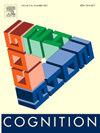基于特征的过滤决定了注意力增强效应中基于对象的选择
IF 2.8
1区 心理学
Q1 PSYCHOLOGY, EXPERIMENTAL
引用次数: 0
摘要
我们通过两个实验研究了注意力增强效应(ABE)的选择机制。参与者完成了一项改进的快速连续视觉呈现(RSVP)任务,在记忆背景图像的同时检测多特征目标。实验1比较了目标匹配干扰(与目标有相同特征)与目标不匹配干扰(没有相同特征)对图像的记忆表现。尽管有部分特征重叠,但目标匹配的干扰物与目标不匹配的干扰物相比没有记忆优势;两者的内存都低于与目标或基线配对的图像。实验二采用颜色-颜色连词来测试具有所有目标特征的干扰物(但在空间上排列不同)是否会增强记忆。与两个匹配的干扰物配对的图像比与其他干扰物配对的图像记忆明显更好,表明其促进效应与目标相当。综上所述,这些发现表明,ABE在对象级别运行,并通过基于特征的滤波进行调制。研究结果进一步表明,时间选择本身并不能完全解释ABE;还必须考虑基于对象的机制。本文章由计算机程序翻译,如有差异,请以英文原文为准。
Feature-based filtering determines object-based selection in the attentional boost effect
We investigated the selection mechanisms underlying the attentional boost effect (ABE) in two experiments. Participants performed a modified rapid serial visual presentation (RSVP) task, memorizing background images while detecting a multi-featured target. Experiment 1 compared memory performance for images paired with target-match distractors (sharing one feature with the target) versus target-nonmatch distractors (no shared features). Despite partial feature overlap, target-match distractors conferred no memory advantage relative to target-nonmatch distractors; memory for both was lower than for images paired with the target or baseline. Experiment 2 employed color–color conjunctions to test whether distractors sharing all target features (but arranged differently in space) would enhance memory. Images paired with both-match distractors were remembered significantly better than those paired with other distractors, indicating a boost effect comparable to that of the target. Taken together, these findings indicate that the ABE operates at the object level and is modulated by feature-based filtering. The findings further suggest that temporal selection alone cannot fully account for the ABE; object-based mechanisms must also be considered.
求助全文
通过发布文献求助,成功后即可免费获取论文全文。
去求助
来源期刊

Cognition
PSYCHOLOGY, EXPERIMENTAL-
CiteScore
6.40
自引率
5.90%
发文量
283
期刊介绍:
Cognition is an international journal that publishes theoretical and experimental papers on the study of the mind. It covers a wide variety of subjects concerning all the different aspects of cognition, ranging from biological and experimental studies to formal analysis. Contributions from the fields of psychology, neuroscience, linguistics, computer science, mathematics, ethology and philosophy are welcome in this journal provided that they have some bearing on the functioning of the mind. In addition, the journal serves as a forum for discussion of social and political aspects of cognitive science.
 求助内容:
求助内容: 应助结果提醒方式:
应助结果提醒方式:


